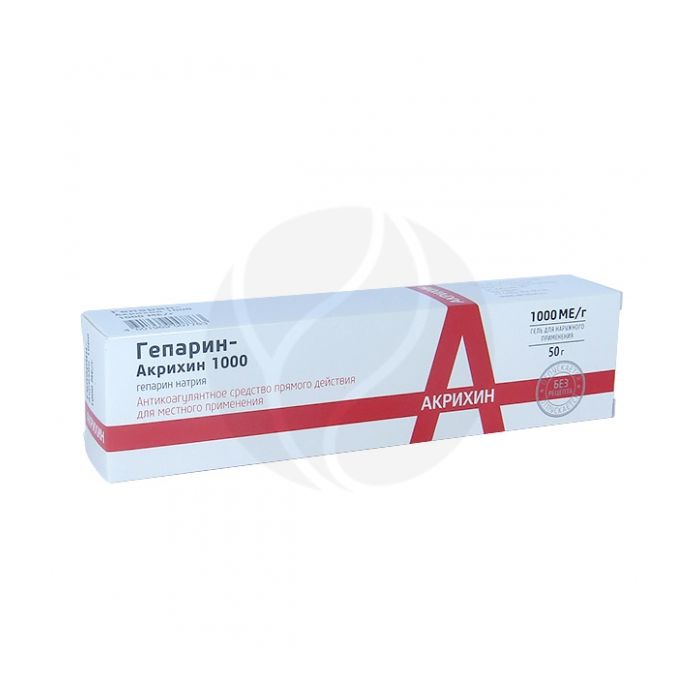Heparin - Akrihin gel 1000ME, 50 g
Expiration Date: 11/2025
Russian Pharmacy name:
Гепарин - Акрихин гель 1000МЕ, 50 г
Thrombophlebitis of superficial veins; localized infiltrates and swelling of soft tissues; tendon and joint injuries, soft tissue and joint injuries.
Outwardly. The gel is applied in a thin layer to the affected area at the rate of 3-5 cm of gel on a skin with a diameter of 3-5 cm and gently rubbed into the skin.
Apply 1-3 times a day every day until the inflammation disappears, on average from 3 to 7 days. The terms of treatment are determined by the doctor.
100 g of gel contain:
active substance: sodium heparin in terms of dry matter - 0.83 g (1000 ME);
excipients: methyl parahydroxybenzoate - 0.15 g, carbomer 940 - 1.25 g, trometamol - 0.85 g, ethanol 96% (rectified ethyl alcohol) - 24 g, lavender oil - 0.02 g, orange blossom oil (neroli oil) - 0.01 g, purified water - up to 100 g.
Hypersensitivity to any of the components of the drug, ulcerative necrotic changes in the skin at the sites of the intended application of the gel, traumatic violation of the integrity of the skin, decreased blood clotting, thrombocytopenia.
Trade name of the drug:
Heparin-Akrikhin 1000
International non-proprietary name:
sodium heparin
Dosage form:
gel for external use
Composition
100 g of gel contain:
active substance: sodium heparin in terms of dry matter - 0.83 g (1000 ME);
excipients: methyl parahydroxybenzoate - 0.15 g, carbomer 940 - 1.25 g, trometamol - 0.85 g, ethanol 96% (rectified ethyl alcohol) - 24 g, lavender oil - 0.02 g, orange blossom oil (neroli oil) - 0.01 g, purified water - up to 100 g.
Description
Transparent or almost transparent, colorless or slightly yellowish gel with a specific odor.
Pharmacotherapeutic group:
direct-acting anticoagulant for topical use
Pharmacological properties
Pharmacodynamics
Direct anticoagulant, anti-inflammatory, antiproliferative, decongestant and analgesic effect. Reduces platelet aggregation, binds to antithrombin III, preventing the transition of prothrombin to thrombin. Inhibits the activity of thrombin. Reduces the activity of hyaluronidase, increases the fibrinolytic properties of the blood. Improves microcirculation and activates tissue metabolism, thereby accelerating the processes of resorption of hematomas and blood clots, ultimately restoring the patency of veins, clinically accompanied by a pronounced analgesic and anti-inflammatory effect.
Pharmacokinetics
A small amount of heparin is absorbed from the skin surface into the systemic circulation. The maximum concentration of the active substance in the blood is observed 8 hours after application. Excretion of heparin mainly occurs through the kidneys, with a half-life of 12 hours.
Indications for use
Thrombophlebitis of superficial veins; localized infiltrates and swelling of soft tissues; tendon and joint injuries, soft tissue and joint injuries.
Contraindications
Hypersensitivity to any of the components of the drug, ulcerative necrotic changes in the skin at the sites of the intended application of the gel, traumatic violation of the integrity of the skin, decreased blood clotting, thrombocytopenia.
Application during pregnancy and lactation
The drug is not contraindicated for use during pregnancy and lactation.
Method of administration and dosage
Outwardly. The gel is applied in a thin layer to the affected area at the rate of 3-5 cm of gel on a skin with a diameter of 3-5 cm and gently rubbed into the skin.
Apply 1-3 times a day every day until the inflammation disappears, on average from 3 to 7 days. The terms of treatment are determined by the doctor.
Side effect
Allergic skin reactions, flushing of the skin.
Overdose
Overdose is unlikely due to the low absorption of the components of the gel. It is manifested by bleeding. It is removed with protamine sulfate (chemical antagonist).
Interaction with other medicinal products
It is not recommended to mix with other external products.
Do not prescribe locally simultaneously with non-steroidal anti-inflammatory drugs, tetracyclines, antihistamines.
The combined use of the gel with oral anticoagulants may cause prolongation of the prothrombin time.
special instructions
It is not recommended for use in case of bleeding, as well as on open wounds, mucous membranes and in the presence of local purulent processes.
Use with extreme caution in case of increased vascular permeability.
The use of the gel is not recommended for deep venous thrombosis.
Release form
Gel for external use 1000 IU / g.
30 or 50 g in an aluminum tube. Each tube, together with instructions for use, in a cardboard box.
Storage conditions
At a temperature of 15 to 25 ? C. Keep out of the reach of children,
Shelf life
2 years. Do not use after the expiration date.
Conditions of dispensing from pharmacies
Without recipe.

